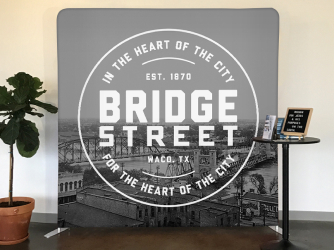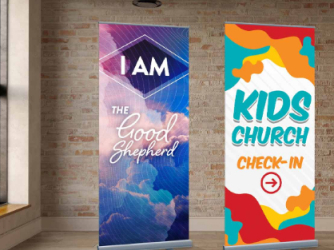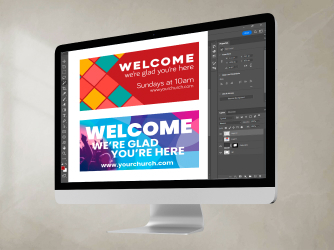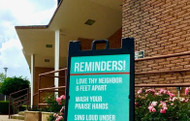Communicating your Church’s COVID Safety Plan
26th Aug 2020
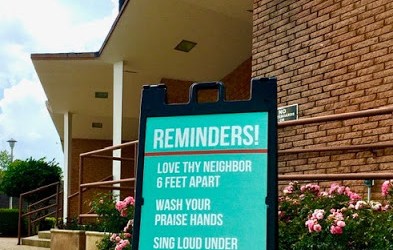
Unfortunately, we’ve all heard the public health news where church officials find out that someone who attended their church service has tested positive for the COVID-19 virus. This is an opportunity for your community to see that you either took necessary precautions or you weren’t being attentive to safety during your church services.
While you as church leaders lead in a delicate balance in any typical situation, the current situation of whether or not to re-open, and to what degree is even more taxing. If your church has made the decision to resume in-person worship services (to one extent or another) then the responsibility lies on you to remind your church members to practice social distancing and proper hygiene and allow people to determine to what extent they are personally comfortable.
It’s fairly clear that in highly-populated areas that the risks of transmitting the COVID virus are different than in more rural areas. This isn’t to say that your church is right or wrong in making your decision. Our goal is to help you communicate your decision in the best possible way.
Use Consistent Terminology:
When you’re designing signage for your foyer, parking lot, entrance area, kids hallway, restrooms, and deciding what to say during your in-service announcements, keep your terminology matching. If you talk about masks being recommended, then use that terminology whenever you refer to masks. If your masks are required, then stick with that word.
There is a difference between face masks being recommended and masks being required – so be sure to decide which you’ll use and communicate it to your prayer team, your ushers, your greeters, and everyone who helps make your worship service happen. Your staff members will need to be on board and lead the way with your decision.
While you can be intentional with what you print on your signage, your communication during service is a little more fluid – it’s someone standing on stage and talking about what’s going on. If you think there’s a chance of confusing the terminology during your announcements (for instance, it’s happened before to any extent), then write a script and pre-record your church service announcements. This isn’t the time to take a chance on miscommunicating.
Over Communicate About Safety at your Church:
At the risk of inspiring a flurry of hand-written posters all over your doors, we recognize that most churches default to under-communicating. Your congregation needs more than a sign on the door as they walk in to be regularly reminded about respecting the wishes of other people at your church.
Have weather-resistant signage in the parking lot letting people know about your mask policy, and a reminder to smile under that mask. Have signage on your doors about asking people before shaking hands or running up to give them a hug. Post about handwashing in your restrooms, and be clear about how you’ll handle high-touch objects like the offering plate or an attendance record clipboard.
For some churches, additional signage may be necessary to show an offering station instead of passing a plate, a hand-sanitizer dispenser, or the location of where parents can pick up activities for their children to do during church service if there are no classrooms open.
Reach Out To Your Community:
Offer an interest piece or community piece to your local newspaper about your decision and why you’re making it. Submit an event to your radio’s community event calendar about reopening. Post a video on Facebook explaining what to expect when people come back to your church where you show your signage and explain your procedures and expectations.
When your church is present in your community and explaining exactly what you’re doing and why then you build a level of comfort and trust. It’s much better for someone to see what you’re doing, hear from your pastor, and understand your motivation before your church reopens than to go public with questions afterward and you have to be on the defensive.
Send out postcards, post regularly on social media, and equip your church members to invite your community to participate with your online church service.
Include Clear Information on your Church Website Home Page:
If the press is going to run a story about your church as it relates to your decisions surrounding COVID and social distancing at your church, they are going to visit your website’s home page. While they’re looking for information connect them to an email address or a content source to see what your church policies are.
If your community or local health officials are interested in visiting or is skeptical about your decision to meet, they’re also going to land on your website home page. There’s no need to go into a biblical explanation on your decision, or theological depths about your take on coronavirus, or your faith on the matter, but on the home page of your website, focus on what you’re doing about it.
Things like “We are taking these measures…” or “We are limiting gatherings to… and here is how….” or “We will be practicing social distancing by…” – include a few pictures of your worship space, entrance or volunteer teams participating in your protocol.
Have a Welcoming Banner in Front of Your Church Building:
If the press, (or really anyone with a phone in their pocket and a social media account) chooses to take a picture of your church building – with whatever intent they may have – be sure that their picture is going to include a banner letting people know that your church service is available online, or that you’re gathering in person again.
Try taking a picture of a bottle of coca-cola where you can’t see the red label or the coca-cola logo. It’s nearly impossible. They’ve positioned their product so that people will recognize it in any context.
Position your church building in the same way. If a journalist can’t get a good picture of your church that doesn’t include a sign that says “You’re welcome to join us safely in person or online” – then it’s hard for them to write that your church isn’t being safe with your protocols.
If your church is downtown or in an area where you don’t have a front lawn for a banner, then hang a banner inside the window, or drape a vinyl banner on the front of your building, or put out an A-frame sign on the sidewalk. Make it as easy as possible for people to recognize that you’re open AND if they would prefer, they have the option of watching online if they are concerned about COVID 19.










